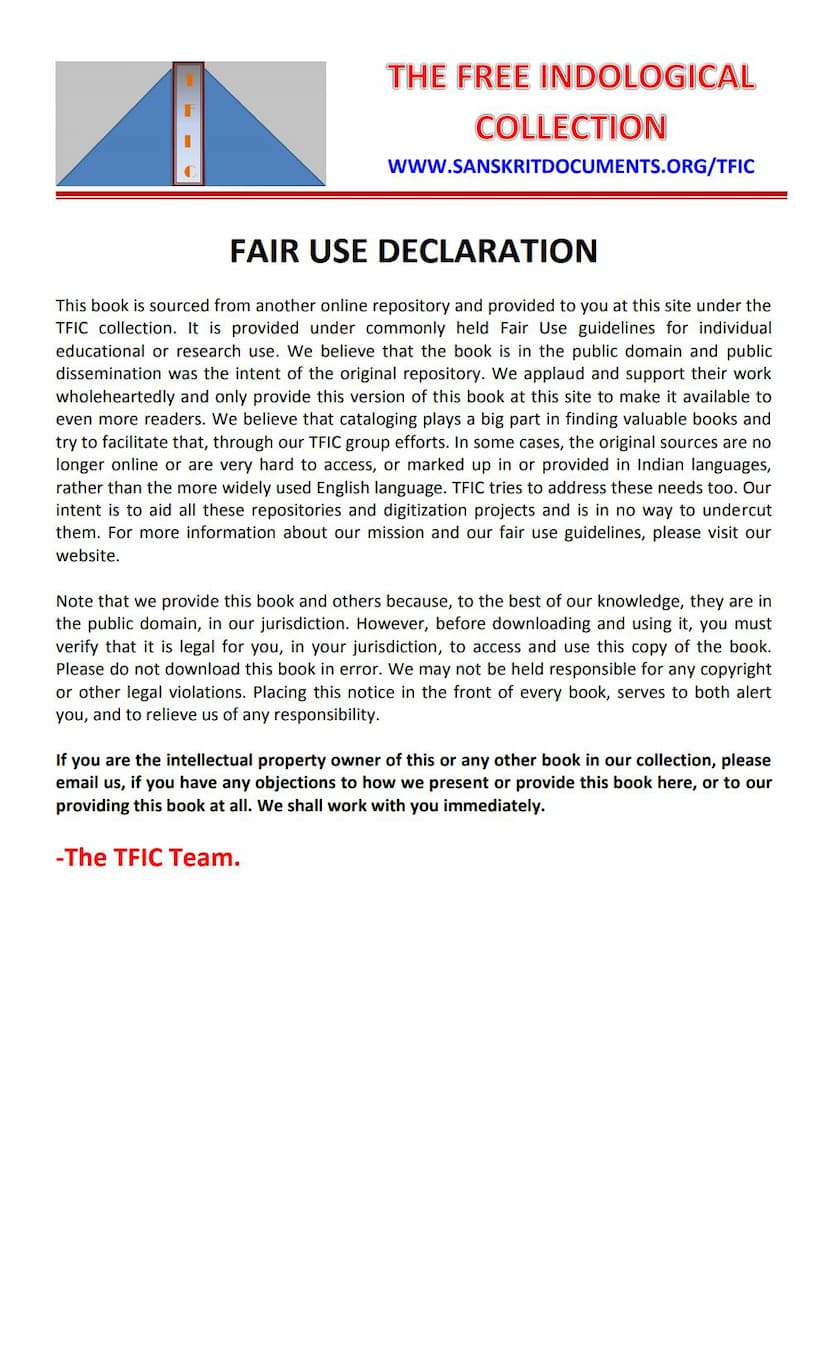Bramhasutra Bhashya Nirnaya
Added to library: September 1, 2025

Summary
Here is a comprehensive summary of the provided Jain text, "Bramhasutra Bhashya Nirnaya," in English:
Book Title: Bramhasutra Bhashya Nirnaya Author(s): Ramkrishna Sevamrut Prakashan Kashi Publisher: Ramkrishnua Sevamrut Prakashan Kashi Catalog Link: https://jainqq.org/explore/010175/1
Overall Summary:
"Bramhasutra Bhashya Nirnaya" is a profound work that critically analyzes the Bramha Sutras and their various commentaries, particularly focusing on identifying and upholding the true interpretation according to the principles of Vyasa, the author of the Bramha Sutras. The text endeavors to resolve interpretive differences by meticulously examining the structure of the Sutras, the lineage of commentaries, the adherence to scriptural evidence, and the logical coherence of arguments. It highlights the challenges in discerning Vyasa's original intent amidst diverse philosophical schools and interpretations, particularly contrasting the interpretations of Shankara, Ramanuja, Madhva, Nimbaarka, Srikantha, Sripathi, Vallabha, and Vijnana Bhikshu. The book emphasizes that the ultimate authority lies in the original Vedas and the author's intent, which is sought to be understood through rigorous analysis of the Sutras, their grammatical structure, and their conformity with Vedic principles.
Key Themes and Arguments:
-
Divergent Interpretations of Bramha Sutras: The core of the text lies in its comprehensive analysis of the Bramha Sutras and the various Bhashyas (commentaries) written on them by different Acharyas (scholars). It meticulously points out the discrepancies and differences in interpretation among prominent commentators like Shankaracharya, Ramanujacharya, Madhvacharya, Nimbarkacharya, Srikanthacharya, Sripathacharya, Vallabhacharya, and Vijnana Bhikshu.
-
Focus on Vyasa's Intent: The primary goal of the book is to ascertain the true meaning and intent of Vyasa, the author of the Bramha Sutras. It argues that the original intent of Vyasa should be the guiding principle in understanding the Sutras, and any interpretation deviating from it, even if logically presented by later commentators, is to be critically examined.
-
Methodology of Interpretation: The text employs a rigorous analytical methodology to determine Vyasa's intended meaning. This involves:
- Grammatical Analysis (Shastra Niyama): Paying close attention to the grammatical structure of the Sutras, including the role of different parts of speech (like pronouns, particles, and conjunctions such as 'ch', 'tu', 'api', 'hi', 'chet', etc.) to understand their specific meaning and implication.
- Contextual Analysis (Vakyanvay): Examining the relationship between Sutras and their context within the broader philosophical discourse, considering the flow of argument from one Sutra to the next and across chapters (Adhyayas) and sections (Padas).
- Scriptural Evidence (Shruti Pramana): Prioritizing Vedic injunctions and statements as the ultimate source of truth and logic, and evaluating all philosophical arguments based on their conformity with these scriptural authorities.
- Logical Coherence (Yukti): While acknowledging the primacy of Shruti, the text also considers the logical consistency and coherence of interpretations.
- Identifying Original Intent: The primary aim is to uncover Vyasa's original intent, which is believed to be directly reflected in the Sutras and supported by the Upanishads.
-
Critique of Commentaries: The book systematically analyzes the major commentaries on the Bramha Sutras, highlighting the specific points where each commentator deviates from what the author considers the true meaning of Vyasa's work. It identifies "doshas" (faults or flaws) in their interpretations based on the methodology outlined above, particularly when they deviate from the original intent or rely on interpretations not supported by the primary sources or logical consistency.
-
Hierarchy of Authority: The text implicitly suggests a hierarchy of authority, with the Bramha Sutras themselves, as expounded by Vyasa, being the ultimate source. The validity of subsequent commentaries is judged based on their fidelity to this original intent and their adherence to scriptural evidence and logical reasoning.
-
Focus on Orthodoxy and Vedic Principles: The work strongly emphasizes adherence to the core principles of Vedic dharma and the philosophical schools that are considered orthodox (astika) and aligned with Vedic teachings. It often critiques interpretations that appear to diverge from these foundational principles, possibly hinting at a need to reconcile or uphold traditional Vedic understanding.
-
Detailed Sutra-by-Sutra Analysis: The book provides an extremely detailed analysis, chapter by chapter, section by section (Pada), and even Sutra by Sutra. It categorizes the Sutras based on their logical connections and argumentative structure, thereby attempting to build a coherent philosophical framework. The catalog of Sutras and their discussions with various commentary references (Shankara, Bhaskara, Ramanuja, etc.) at the end suggests a deep dive into textual variations and interpretations.
-
Critique of Later Commentaries: The analysis reveals that while Shankara's commentary is often presented as the most consistent with the inferred principles of Vyasa, other commentators like Ramanuja, Madhva, and Nimbarka are shown to have differing interpretations, often attributed to the introduction of their own specific philosophical frameworks or interpretations of scriptural passages. The text carefully points out the specific Sutras where these differences arise and where, according to the author's perspective, the deviation from the established principles occurs.
In essence, "Bramhasutra Bhashya Nirnaya" is a scholarly effort to establish the correct philosophical framework of the Bramha Sutras, drawing upon a critical comparative analysis of traditional commentaries and prioritizing the original intent of the author, Vyasa, as understood through Vedic principles and logical reasoning.